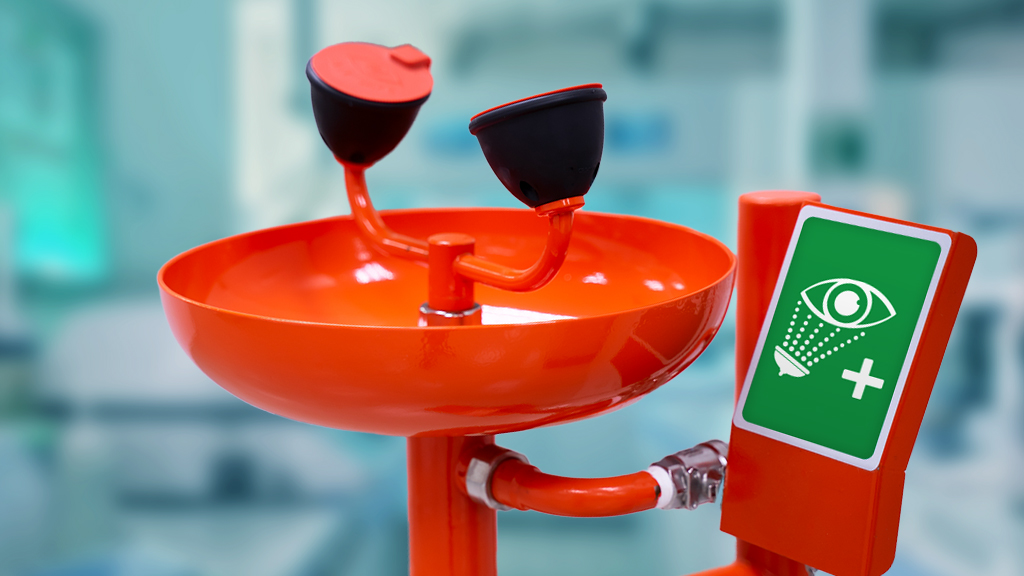Safety Blog
Instructional Space Eyewash Station Safety Protocols
By Ken Roy
Posted on 2025-01-23

Disclaimer: The views expressed in this blog post are those of the author(s) and do not necessarily reflect the official position of the National Science Teaching Association (NSTA).
The Occupational Safety and Health Administration (OSHA) by reference requires employers to choose safety eyewash stations that comply with ANSI/ISEA Z358.1: American National Standard for Emergency Eyewash and Shower Equipment. In this way, an emergency eyewash station should provide a continuous flow of water to flush affected eyes for at least 15 minutes in the event of a chemical splash. This duration is important to ensure that any harmful substances are thoroughly rinsed out and to minimize potential damage to the eyes. This usually is not an issue with a plumbed emergency eyewash station. A plumbed eyewash station is a permanent fixture that is connected to a constant water source. However, there may be an issue when using an eyewash bottle, given that the bottle can only hold a definitive amount of water.
The following safety protocols are recommended for employees and students needing to use emergency eyewash stations or portable eyewash bottles, in addition to recommended procedures if there is insufficient amount of water to flush eyes for at least 15 minutes.
Part One—Using an emergency eyewash station safely in case of an eye chemical splash involves several important steps.
1. Immediate Action. As soon as a chemical splash occurs, quickly move to the nearest emergency eyewash station.
2. Activate the Station. Turn on the eyewash station immediately. Ensure the water flows freely before using it.
3. Positioning. Lean over the eyewash basin. Hold your eyelids open with your fingers to ensure thorough rinsing.
4. Flush the Eyes. Place your eyes in the stream of water and allow it to flow over the affected eye(s) for at least 15 minutes. Ensure that the water washes over all surfaces of the eye, including under the eyelids.
5. Avoid Rubbing. Do not rub or touch the affected eye, as this can cause further irritation or damage.
6. Continue Rinsing. If necessary, keep your eyes in the water stream for the full duration, even if it feels uncomfortable.
7. Seek Medical Attention. After rinsing, immediately seek medical help by seeing the school nurse, even if you feel fine. Some chemicals can cause delayed reactions.
8. Report the Incident. Students need to inform their teacher about the incident to ensure proper documentation and review of safety protocols. This is also applicable for employees.
Always follow your facility's specific safety procedures and training when using an eyewash station.
Part Two—Using an emergency portable eyewash bottle safely in case of an eye chemical splash involves several important steps.
1. Immediate Response. As soon as a chemical splash occurs, try to remain calm and quickly move to the designated eyewash area.
2. Positioning. Hold the eyewash bottle at eye level and ensure that the nozzle is pointing away from your face to prevent any accidental spraying.
3. Open the Eyes. Use your fingers to hold open the affected eye(s). This will allow the solution to flush out any contaminants more effectively.
4. Rinse Thoroughly. Squeeze the bottle gently to allow the sterile saline solution to flow into the eye. Aim to flush the eye for at least 15 minutes, if possible (see Part Three below). Ensure that the solution runs over the entire surface of the eye, including under the eyelid.
5. Avoid Rubbing. Do not rub your eyes, as this can cause further irritation or damage.
6. Seek Help. After rinsing, seek immediate medical attention by seeing the school nurse, even if you feel better. Some chemicals can cause delayed reactions or damage.
7. Report the Incident. Students need to inform their teacher about the incident so that appropriate safety measures can be taken and document the situation. This is also applicable for employees.
Remember, always follow safety protocols and procedures for handling chemical spills.
Part Three—If using a portable eyewash bottle and it runs out of water before you can flush the affected eye for the recommended 15 minutes, take the following alternative actions.
1. Find a Secondary Source. Immediately look for another eyewash station or a sink with clean, running water. If available, use a faucet to continue rinsing the eye.
2. Use a Water Bottle. If you have access to bottled water (preferably sterile or purified), you can use it to continue flushing the eye. Pour it gently into the eye while keeping the eyelid open.
3. Seek Assistance. If you’re in a lab setting, call for help or alert a teacher, supervisor, or school nurse to bring additional eyewash supplies.
4. Tilt the Head. If using a faucet or water bottle, tilt the head to allow water to flow from the inner corner of the eye to the outer corner. This helps wash out contaminants effectively.
5. Do Not Delay Medical Attention. After rinsing, seek immediate medical assistance from the school nurse, regardless of how long you were able to flush the eye. This ensures that any potential damage is assessed and treated properly.
Always prioritize safety and follow your school’s emergency protocols in these situations.
Submit questions regarding health and safety issues in science/STEM instructional spaces to Ken Roy at safersci@gmail.com.
Follow Ken Roy on X: @drroysafersci. You can also follow Dr. Roy on LinkedIn at https://www.linkedin.com/in/dr-ken-roy-07218713/.
Safety Middle School High School Postsecondary


